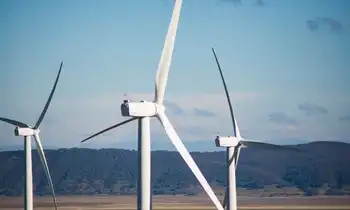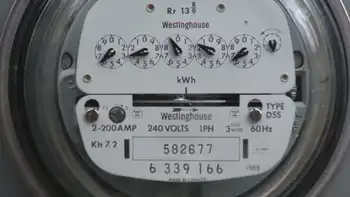Power from restless sea stirs the imagination
By New York Times
Arc Flash Training CSA Z462 - Electrical Safety Essentials
Our customized live online or in‑person group training can be delivered to your staff at your location.

- Live Online
- 6 hours Instructor-led
- Group Training Available
But the technical difficulties of making such systems work are proving formidable. Last year, a wave-power machine sank off the Oregon coast. Blades have broken off experimental tidal turbines in New YorkÂ’s turbulent East River. Problems with offshore moorings have slowed the deployment of snakelike generating machines in the ocean off Portugal.
Years of such problems have discouraged ocean-power visionaries, but have not stopped them. Lately, spurred by rising costs for electricity and for the coal and other fossil fuels used to produce it, they are making a new push to overcome the barriers blocking this type of renewable energy.
The Scottish company Pelamis Wave Power plans to turn on a small wave-energy farm — the world’s first — off the coast of Portugal by year’s end, after fixing the broken moorings. Finavera Renewables, a Canadian company that recently salvaged its sunken, $2.5 million Oregon wave-power machine, has signed an agreement with Pacific Gas & Electric to produce power off the California coast by 2012. And in the East River, just off Manhattan, two newly placed turbines with tougher blades and rotors are feeding electricity into a grocery store and parking garage on Roosevelt Island.
“It’s frustrating sometimes as an ocean energy company to say, yeah, your device sank,” said Jason Bak, chief executive of Finavera. “But that is technology development.”
Roughly 100 small companies around the world are working on converting the seaÂ’s power to electricity. Many operate in Europe, where governments have pumped money into the industry. Companies and governments alike are betting that over time, costs will come down. Right now, however, little electricity is being generated from the ocean except at scattered test sites around the world.
The East River — despite its name, it is really a tidal strait with powerful currents — is the site of the most advanced test project in the United States.
Verdant Power, the company that operates it, was forced to spend several years and millions of dollars mired in a slow permit process, even before its turbine blades broke off in the currents. The company believes it is getting a handle on the problems. Verdant is trying to perfect its turbines and then install 30 of them in the East River, starting no later than spring 2010, and to develop other sites in Canada and on the West Coast.
Plenty of other start-ups also plan commercial ocean-power plants, at offshore sites such as Portugal, Oregon and Wales, but none have been built.
Ocean-power technology splits into two broad categories, tidal and wave power. Wave power, of the sort Finavera is pursuing, entails using the up and down motions of the waves to generate electricity. Tidal power — Verdant’s province — involves harnessing the action of the tides with underwater turbines, which twirl like wind machines.
(Decades-old tidal technologies in France and Canada use barrage systems that trap water at high tide; they are far larger and more obtrusive than the new, below-waterline technologies.)
A third type of power, called ocean thermal, aims to exploit temperature differences between the surface and deep ocean, mainly applicable in the tropics.
Ocean power has more potential than wind power because water is about 850 times denser than air, and therefore packs far more energy. The oceanÂ’s waves, tides and currents are also more predictable than the wind.
The drawback is that seawater can batter and corrode machinery, and costly undersea cables may be needed to bring the power to shore. And the machines are expensive to build: Pelamis has had to raise the equivalent of $77 million.
Many solar start-ups, by contrast, need as little as $5 million to build a prototype, said Martin Lagod, co-founder of Firelake Capital Management, a Silicon Valley investment firm. Mr. Lagod looked at investing in ocean power a few years ago and decided against it because of the long time horizons and large capital requirements.
General Electric, which builds wind turbines, solar panels and other equipment for virtually every other type of energy, has stayed clear of ocean energy. “At this time, these sources do not appear to be competitive with more scalable alternatives like wind and solar,” said Daniel Nelson, a GE spokesman, in an e-mail message. (An arm of GE has made a small investment in Pelamis.)
Worldwide, venture capital going to ocean-power companies has risen from $8 million in 2005 to $82 million last year, according to the Cleantech Group, a research firm. However, that is a tiny fraction of the money pouring into solar energy and biofuels.
This month the Energy Department doled out its first major Congressionally-funded grants since 1992 to ocean-power companies, including Verdant and Lockheed Martin, which is studying ocean thermal approaches.
Assuming that commercial ocean-power farms are eventually built, the power is likely to be costly, especially in the near term. A recent study commissioned by the San Francisco Public Utility Commission put the cost of harnessing the Golden GateÂ’s tides at 85 cents to $1.40 a kilowatt-hour, or roughly 10 times the cost of wind power. San Francisco plans to forge ahead regardless.
Other hurdles abound, including sticky environmental and aesthetic questions. In Oregon, crabbers worry that the wave farm proposed by Ocean Power Technologies, a New Jersey company, would interfere with their prime crabbing grounds.
“It’s right where every year we deploy 115,000 to 120,000 crab pots off the coast for an eight-month period to harvest crab,” said Nick Furman, executive director of the Oregon Dungeness Crab Commission. The commission wants to support renewable energy, but “we’re kind of struggling with that,” Mr. Furman said.
George Taylor, chief executive of Ocean Power Technologies, said he did not expect “there will be a problem with the crabs.”
In Washington State, where a utility is studying the possibility of installing tidal power at the Admiralty Inlet entrance to Puget Sound, scuba divers are worried, even as they recognize the need for clean power.
Said Mike Racine, president of the Washington Scuba Alliance: “We don’t want to be dodging turbine blades, right?”











